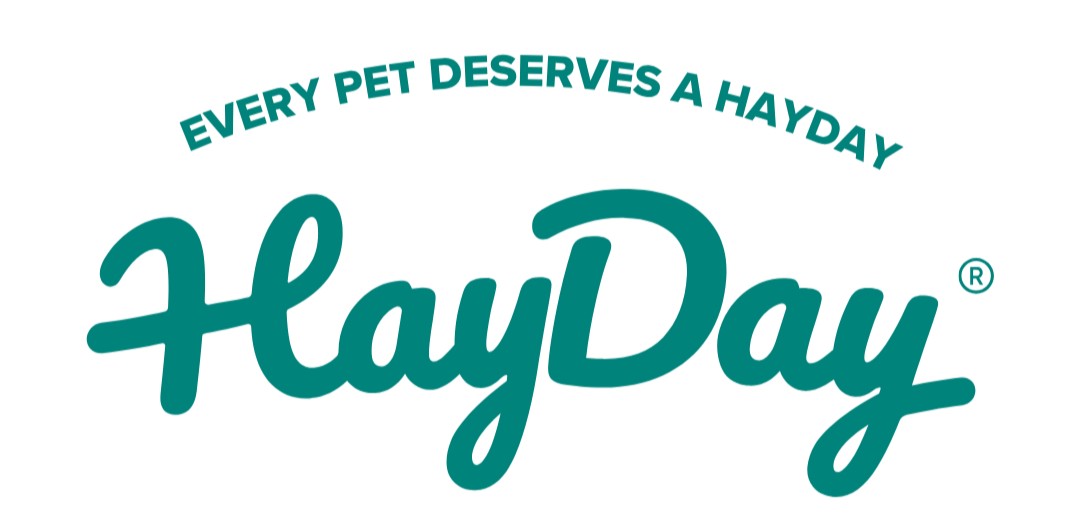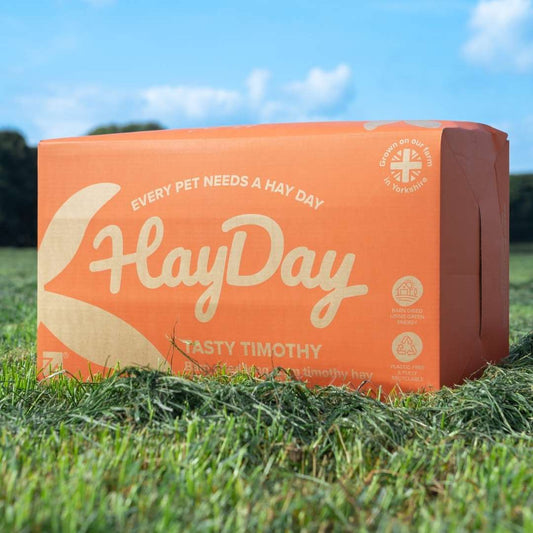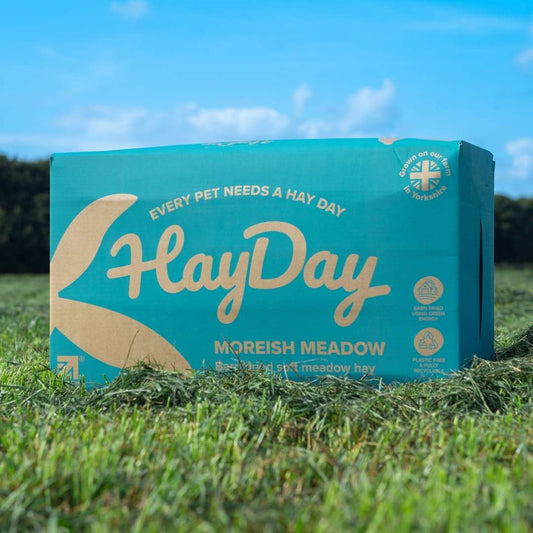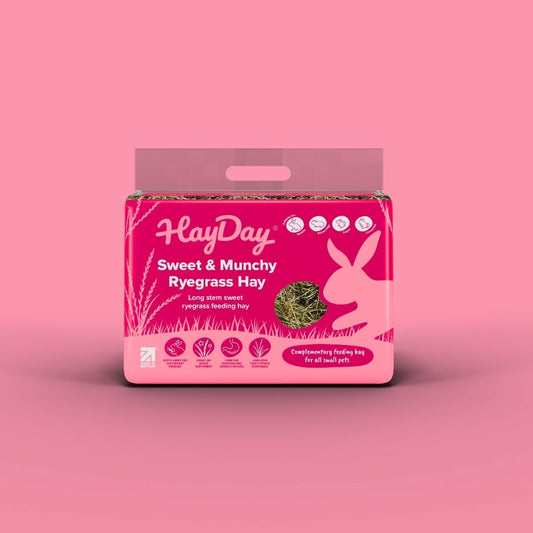For small pet owners, choosing the right types of hay is essential for your furry friend's health.
This article explores the best types of hay for different small pets; including rabbits, guinea pigs, chinchillas and degus. We'll detail their specific benefits and how they can improve your animals’ well-being and overall health.
We have a wide range of hay options here at HayDay HQ, but you may be wondering what the differences are and which to feed your small pet.
Let's delve into our favourite topic with our expert guide on the main types of hay for pets available for companion animal lovers far and wide.
Shop now > Premium, barn dried hay boxes for small pets.
What animals eat hay?
Small herbivorous animals such as rabbits, guinea pigs, chinchillas, and degus eat hay as a vital part of their diet. The various grass hay types provide essential fibre that supports their digestive health and helps wear down their continuously growing teeth, preventing dental problems.
These animals rely on different kinds of hay like Timothy, Meadow, and Oat hay to meet their nutritional and functional needs. Feeding fibrous hay mimics their natural foraging behavior and is key to maintaining their overall well-being .
Pet Hay Types Overview
When choosing a type of pet hay, there are two key considerations:
-
What it provides in terms of nutrients
-
What it offers in terms of its functional role for maintaining dental and digestive health.
From a functional point of view, the overall fibre level and type of fibre in the hay is important for small animals.
Insoluble fibre content (fibre which cannot be broken down) is key for helping to maintain digestive and dental function.
Which is the best type of hay to buy?
Choosing the right type of hay is crucial for the health and wellbeing of your animals.
-
Timothy Hay, with its high fibre and protein content, is ideal for digestive and dental health in small herbivores.
-
Meadow Hay offers a mix of textures and flavours that are suitable for fussy eaters and provide foraging enrichment.
-
Ryegrass Hay provides enhanced nutrition and a sweet taste, while Alfalfa Hay, high in protein and calcium, supports the growth and health of young, pregnant, or unwell animals.
-
Orchard Hay is an excellent alternative to Timothy Hay
-
Oat Hay adds variety to the diet with its unique textures and tastes.
It is also helpful to know that hay is different to straw, so be careful not to assume that they provide the same nutritional value.
Hay Nutritional Value Comparison
Different types of hay, can significantly vary in nutritional value.
| Tasty Timothy Hay | Moreish Meadow Hay | Ryegrass Hay | Alfalfa Hay | |
| Crude Protein (%) | 8 | 7 | 9 | 20 |
| Crude Fibre (%) | 32 | 30 | 26 | 27 |
| Crude Fats and Oils (%) | 2.4 | 1.7 | 1.5 | 1.6 |
| Crude Ash (%) | 2.4 | 3.9 | 6.5 | 6.5 |
| Sodium (%) | 0.01 | 0.1 | 0.03 | 0.03 |
Feeding Recommendations
The specific nutritional needs of animals dictate the feeding recommendations for different types of hay. Here's a feeding guideline from our in-house nutritionist Briony:
From a nutritional point of view, consider our three grass hay products on a ladder.Being at the top of the ladder, offering the most nutrients makes the Ryegrass Hay most suitable for young, growing or breeding (and senior) pets while Moreish Meadow or Tasty Timothy can be better suited to mature small animals providing lower levels of calories/energy and protein. The latter two are a great choice to feed every day as part of your small pet's diet.
If you have any questions at all about our products or how to select the most appropriate hay for your pet, get in touch with our team.
The Different Kinds Of Hay Explained
Timothy Hay
Small herbivores such as rabbits and guinea pigs thrive on Timothy Hay thanks to its high fibre and protein content which promotes digestive and gut health. The benefits of feeding Timothy Hay include:
-
High fibre content
-
High protein content
-
Aids in wearing down continually growing teeth of rabbits and guinea pigs
-
Prevents common rabbit and guinea pig issues like gastrointestinal stasis
It’s no wonder Timothy Hay, also known as Timothy grass, is often considered the gold standard in small pet nutrition.
One of the distinct features of Timothy Hay is its availability in three different cuts, each offering varying nutritional values. Here are the three cuts and their characteristics:
-
First cut: This cut has the highest fibre content and is coarser in texture making it ideal for dental health.
-
Second cut: This cut strikes a balance between fibre and protein, providing a good mix of nutrition and palatability
-
Third cut: This cut is typically somewhat softer in texture
At HayDay, our Tasty Timothy is a beautifully green, premium quality hay that grows up to four feet tall and is grown in the Yorkshire countryside. It’s barn-dried to maintain consistent quality all year round and is dust-extracted to ensure it’s safe and healthy for your pets and their respiratory system.
Meadow Hay
Comprising of a mix of various pasture grasses, Meadow Hay offers a diversity in textures and flavours.
This variety not only enhances palatability but also stimulates natural foraging behaviour in small pets, encouraging them to interact and forage with their food as they naturally would in the wild. Its high fibre content is crucial for maintaining gut health, making it an excellent choice for adult small pets.
Another advantage of Meadow Hay is its suitability as bedding hay due to its soft texture. This can help prevent health issues such as hay poke, which can occur with coarser hays in guinea pigs.
Meadow Hay’s versatility and nutritional benefits make it a valuable addition to your pet’s diet, ensuring they remain healthy and happy for life.
Ryegrass Hay
With a sweet taste and enhanced nutritional value, Ryegrass Hay stands out as a highly palatable option to feed your small pet. This grass hay is particularly beneficial to feed as it provides essential fibre needed for proper digestion and dental health.
Its long, stalky stems help wear down continuously growing teeth, much like other high-quality grass hays. Suitable for adult small pets, Rye Grass Hay can be fed as added enrichment alongside Timothy or Meadow Hay.
It's sweet taste and high nutrition make rye grass hay a favourite among pet owners looking to provide a varied and balanced diet for their animals.
Here's what our nutritionist Briony has to say:
While you can just choose one type of hay, it is very common for small pet owners to feed a combination of hays– this can not only help to satisfy both nutritional and functional requirements but also may offer additional enrichment. For most pets we would recommend that Moreish Meadow or Tasty Timothy form the basis of the daily hay ration with ryegrass (or another hay) being used as a form of enrichment, offered in small quantities alongside your pet’s usual hay.
Alfalfa Hay
Alfalfa Hay, a legume rather than a grass, is known for its high protein and calcium content which is essential for the health and development of young and growing small animals.
While it is not recommended as a staple everyday hay for grown-up rabbits, but can be fed to diversify their diet, it is an excellent choice for:
-
Young pets up to six months old
-
Pregnant animals
-
Growing animals
-
Unwell animals
-
Pets recovering from injury
To diversify your small pets diet, Alfalfa Hay should be fed alongside Timothy or Meadow Hay (which should make up the majority of their diet) in order to provide the essential nutrients.
Alfalfa Hay is part of the same family as clovers and peas, distinguishing it from grass hays like Timothy and Meadow Hay. Its unique composition and nutritional benefits make it a valuable component in the diet of young and special-needs pets.
For those with allergies to other hay types, Orchard Hay, offers a fantastic alternative while providing similar benefits. High in fibre, Orchard Hay is crucial for preventing digestive issues like bloat and stasis in small animals. This grass hay also promotes dental health by naturally wearing down the teeth of small pets. Suitable for adult small pets, Orchard Hay should comprise about 80-90% of their diet to maintain overall health.
Its gentle nature and high nutritional value make it an excellent choice for rabbits, guinea pigs, and chinchillas. Whether you’re looking for a primary hay or an alternative to Timothy, Orchard Hay is a great option to feed.
Oat Hay
Oat Hay, with its unique textures and flavours, is an excellent choice to diversify your small pet’s diet, enhancing their overall feeding experience. Its unique texture and flavour make it a delightful addition to the diet of adult small pets.
Suitable for adult small pets, Oat Hay is not only nutritious but also helps keep their diet diversified.
By including Oat Hay in their feeding routine, you can ensure your pets receive a balanced and enjoyable diet.
Factors Affecting Hay Quality
Several factors influence the quality of hay, including:
-
Harvest
-
Handling and storage
-
The type of grass
-
Weather conditions
All of these factors play a crucial role in hay production. Even with the same species grown under similar conditions, hay quality can vary. Understanding these factors can help you select the best hay for your animals, ensuring they receive the maximum nutritional benefits.
In the following subsections, we’ll delve deeper into the specifics of growth stage, handling and storage, and visual inspection to provide a comprehensive guide to maintaining hay quality.
Harvest
The nutritional value of hay is significantly dependent on a successful harvest. Harvesting hay typically looks like:
-
Growing - Drilling the perfect grass mixes for your pets
-
Mowing - When the grass is ready (and its typically sunny) we mow
-
Tedding - To ensure that the grass is nice and dry, we use a machine to turn it
-
Baling - We then bale the hay in super large bales and cart them back to the farm
-
Drying - using our drying facilities which our powered using green energy
-
Packing - We then perfectly pack the hay into our 1kg and 4.5kg boxes which we ship to your homes
Early-cut hay, harvested just as it begins to bloom (such as Oat Hay), is more nutritious compared to late-cut hay. Ensuring that hay is cut at the optimal stage can significantly enhance its nutritional value and overall quality.
At HayDay, we do the whole process on our farm in Yorkshire so you can rest assured that from field to nibble our hay is of top quality.
Handling & Storage
Quality maintenance of hay relies heavily on its proper handling and storage.
Hay must be fully dried when baled and kept dry in storage to prevent spontaneous combustion, which can occur if hay is baled with too much moisture. Storing hay in a cool, dry place away from direct sunlight helps preserve its freshness.
Good storage techniques are crucial in order to maintain the hay’s nutritional value over time.
Visual Inspection
A simple yet effective method to assess hay quality is through visual inspection. Hay that is green in colour typically indicates it is of premium quality. Conversely, hay which lacks in colour vibrancy (brown) may signal reduced quality.
Odour is an important factor too: hay that smells fresh and sweet is generally of higher quality, while musty or mildewy odours can suggest mould or spoilage.
Regular visual inspections can help you ensure that the hay you provide to your animals is of the highest quality.
Summary
-
Timothy Hay is highly recommended for small herbivores like rabbits and guinea pigs due to its high fibre and protein content, which supports digestive health and dental maintenance.
-
The quality of Meadow Hay, Ryegrass Hay, Alfalfa Hay, Orchard Hay, and Oat Hay varies, each offering unique benefits in terms of fibre content, nutritional value and texture. Making them suitable for different animal needs and dietary requirements.
-
Several factors such as harvest, handling and storage can significantly impact hay quality. With traditional, new and innovative farming techniques ensuring optimal nutritional benefits for animals.
Understanding the factors that affect hay quality such as the harvest, handling, storage, and visual inspection, can help you select the best hay for your animals.
By following feeding recommendations based on the specific nutritional needs of your pets, you can ensure they receive a balanced and nutritious diet, promoting their health and happiness.
Relevant Advice
Timothy Hay vs Meadow Hay - What's the difference?
Frequently Asked Questions
Why is Timothy Hay considered the gold standard for small pets?
Timothy Hay is considered the gold standard for small pets due to its high fibre and protein content, which promotes digestive health and dental care, offering varying nutritional values for different dietary needs.
Can Meadow Hay be used as bedding?
Yes, Meadow Hay's soft texture makes it suitable for bedding and helps prevent health issues like hay poke.
What are the benefits of Ryegrass Hay?
The benefits of Ryegrass Hay include its being sweet-tasting and highly palatable, providing essential fibre for digestion and dental health. It can be fed as enrichment alongside other hays.
When is Alfalfa Hay suitable for feeding?
Alfalfa Hay is suitable for feeding young, pregnant, or unwell animals due to its high protein and calcium content, but it is not recommended as a staple for adult rabbits. For adult pets, it can be mixed with other hays to create diversity in their diet.
How does visual inspection help determine hay quality?
The visual inspection helps determine the quality of hay by looking at its colour and odour; bright green hay with a fresh, sweet smell indicates high quality, while brown hay with a musty odour suggests poor quality.






